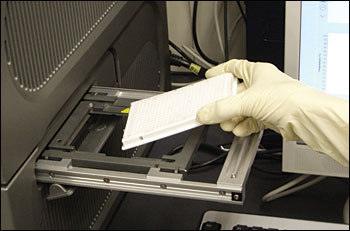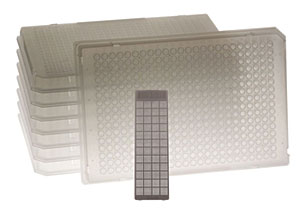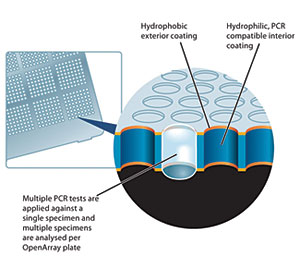
What's New with PCR
Polymerase chain reaction (PCR), the workhorse of biological analysis, is used in areas ranging from criminal investigations and disease diagnosis to biological research. Sometimes referred to as “molecular photocopying,” it is the test, for example, that determines whether a strand of hair found at a crime scene matches that of a certain suspect.
The technique, which incorporates optical components and fluorescence, uses a heat-resistant DNA polymerase from the thermophilic bacterium Thermus aquaticus to accurately replicate manifold small segments of DNA for genetic and molecular analysis, according to Colin J.H. Brenan, co-founder, chief technology officer and senior vice president of business development at BioTrove Inc. in Woburn, Mass.

Researchers in Japan have developed what they say is a faster, more cost-effective, more flexible quantitative PCR test to analyze DNA for medical diagnostics, gene expression analysis, genotyping of individuals, detection of infectious diseases, examination of genetically modified organisms and other applications. (Courtesy of Naohiro Noda)
American biochemist Kary B. Mullis was a co-winner of the 1993 Nobel Prize in chemistry for his work on the PCR technique, considered a highly significant advance in the study of DNA and of nucleic acids in general.
The replicated DNA segments produced by PCR can be used in a variety of laboratory procedures, including most mapping techniques for the Human Genome Project. According to the National Institutes of Health’s National Human Genome Research Institute in Bethesda, Md., the method also is valuable in emerging laboratory and clinical techniques, including DNA fingerprinting; detection of bacteria or viruses, particularly AIDS; and diagnosis of genetic disorders.
The method entails heating a segment of double-stranded DNA so that it denatures, or separates, into two pieces of single-stranded DNA. Taq, a thermostable DNA polymerase, then synthesizes, or builds, two new strands of DNA, using the original strands as templates. The process results in the duplication of the original DNA, with each of the new molecules containing one old and one new strand, according to the institute. Each strand then can be used to create two new copies and so on. The cycle of separating and building DNA is repeated as many as 40 times, leading to more than 1 billion exact copies of the original segment.
PCR systems
The cycling process of PCR is automated and directed by a thermal cycler programmed to alter the temperature of the reaction every few minutes to control the replication. The number of DNA copies is measured by a variety of techniques, with the most popular and convenient ones based on optical measurement involving fluorophores, Brenan said.
An example of a quantitative PCR platform is the OpenArray, a real-time qPCR system based on thermal cycling and fluorescence imaging for measurement of the number of DNA copies. Developed by BioTrove, the system is based on Molecular Probes Inc.’s SYBR Green I, an asymmetrical cyanine dye that binds to double-stranded DNA. The dye has an 800- to one thousandfold fluorescence enhancement when bound to double-stranded DNA relative to single-stranded DNA, Brenan said.

With 3072 separate through holes, the OpenArray plate has the throughput of eight 384-well plates. This innovation allows researchers to finish projects in days instead of weeks, and to save on the cost of reagents. The plate is part of the OpenArray quantitative PCR platform from BioTrove. (Courtesy of BioTrove Inc.)
The OpenArray plate’s 3072 through holes - instead of the 384 or 96 wells in a standard microtiter plate - can be loaded with reagents to perform individual 33-nl real-time PCR reactions. A differential coating process enables the plates to hold solutions in the open through holes via capillary action, enabling simultaneous testing of a large number of nucleic acid samples against a large number of PCR assays in a flexible format, he explained.
The plates, loaded with samples and PCR reagents, are hermetically sealed in transparent glass cases before being placed in the OpenArray NT Cycler. This instrument incorporates a flat block thermal cycler with a cooled CCD imager to measure SYBR Green I intensity in up to three OpenArray plates during thermal cycling. The cycler uses three filtered high-brightness LEDs for excitation and images the fluorescence emission through a wavelength-selective optical filter, he said. Software converts the raw images into meaningful amplification and dissociation curve information.

BioTrove's proprietary coating on the OpenArray plates allows for consistent and efficient loading and cycling in the PCR process. Researchers receive the plates with assays dried down in the 3072 through holes. Each through hole holds 33 nl of sample mix. (Courtesy of BioTrove Inc.)
BioTrove recently launched OpenArray DLP, another real-time qPCR platform, for use with customers’ TaqMan chemistries. TaqMan is another approach to DNA copy measurement based on the dissociation of a Förster resonance energy transfer (FRET) probe by the Taq polymerase, Brenan said. The combination of TaqMan or SYBR Green I chemistries with the OpenArray system for real-time qPCR analysis not only enables better use of staff, reagent supply and resources, but also boosts productivity, the company says.
The OpenArray system allows one user to obtain 30,000 data points in just one day. Applications for the new platform include profiling miRNAs, detecting pathogens, validating microarray results and performing expression-based biomarker screens.
SNP genotyping
In 2008, BioTrove and Applied Biosystems Inc., now a part of Life Technologies Inc. of Carlsbad, Calif., launched the TaqMan OpenArray Genotyping System for PCR-based analysis of single-nucleotide polymorphisms (SNPs), the most common type of genetic variation. Genotyping provides a measurement of the genetic variation between members of a species. Exclusively marketed by Life Technologies, the system enables genomics researchers to generate SNP data in hundreds of thousands of data points per day, according to BioTrove.
“There is currently a strong interest in SNP genotyping analysis. It is a hot area,” Brenan said. “Scientists are interested in genetic analysis, in part so that they can learn and understand the biological mechanisms that distinguish diseased and normal tissue, and how genes change their function in the process of transition from a normal to a diseased state.
“The overall goal of systems like the OpenArray is to enable scientists to test their hypotheses regarding the roles different genes play in a biological pathway or disease under different combinations of experimental conditions and across larger sets of biological specimens.”
The value of the OpenArray, he added, is that it offers researchers a simple, easy-to-use and economical system that quickly provides highly accurate quantitative information.
QProbe system
Naohiro Noda, a researcher at the National Institute of Advanced Industrial Science and Technology in Tsukuba, Japan, and his team have developed what they say is a faster, more cost-effective version of the traditional PCR method. Noda said that the method, called the universal QProbe system, can be carried out using a standard real-time PCR system and does not require any special facility for wider application.
Unlike existing PCR processes that require several fluorescent probes to seek out the DNA, he said, their technique uses a single fluorescent probe that can detect virtually any DNA target, significantly reducing the cost of setup in comparison with other sequence-specific fluorescent PCR techniques. The method uses a three-tailed DNA probe that is specific for target sequences, enabling accurate quantification even in the presence of nonspecific PCR products.
“This method can significantly reduce the cost of an SNP genotyping setup because SNPs can be genotyped by employing the same probe,” Noda said.
The LightCycler 480 and 1.5 thermal cyclers from Roche Applied Science, a business unit of Roche based in Basel, Switzerland, were used in the research. The instruments can measure the fluorescence intensity in every PCR tube during the process, Noda said. A full report on the QProbe system can be found in the July 15, 2009, issue of Analytic Chemistry.
Noda noted that several advances have been made in the optics-/photonics-based PCR method. Real-time PCR now can be performed rapidly with high sensitivity and reproducibility, and there no longer is a need to perform electrophoresis after the method because the amplified products can be monitored using the fluorescent probes or fluorescent dye. Therefore, there is a low risk of carryover contamination, he added.
The main drawback of the optics-/photonics-based PCR system, Noda explained, is that it requires highly specialized and expensive devices such as a real-time PCR machine equipped with a fluorometer and a thermal cycler, making it unsuitable for on-site gene quantification.
Diagnostic tests for TB, H1N1 swine flu
Roche Diagnostics, another business unit of Roche, recently launched a PCR assay to expedite testing for tuberculosis in South Africa, where there is a high incidence of the disease. Tested in analytical and clinical trials with national laboratories and a hospital, the kit detects various species of Mycobacterium from human sputum using the company’s LightCycler 2.0 instrument.
Scientists currently rely on smear microscopy and culture methods to identify the most infectious patients, techniques that lack sensitivity and specificity and that can result in longer turnaround times for patients, the company says. The new test offers advantages because it enables differentiation between Mycobacterium tuberculosis, Mycobacterium avium and Mycobacterium kansasii in a single PCR run, and it provides accurate results within hours, the company says.
Led by Laetitia Ninova, scientists from Université de la Méditerranée and Institut de Recherche pour le Développement in Marseille, France, and from other organizations have developed a molecular probe that improves on the existing PCR assay used to diagnose seasonal influenza. It also enables detection of both the seasonal human-origin and H1N1 swine-origin influenza A viruses in the same patient using a simple test protocol. They presented a real-time one-step transcriptase-PCR SYBR Green assay derived from a method reported by investigators in 2001 that ensures rapid, sensitive and cost-effective detection of both viruses.
Their findings also suggest that the test could be modified easily to detect newly emerging viral variants, including avian influenza strains. The related scientific article titled “A Simple Method for Molecular Detection of Swine-Origin and Human-Origin Influenza A Virus” was published online ahead of print in the journal Vector-Borne and Zoonotic Diseases.
New system
The new LightCycler 1536, a real-time PCR system from Roche Applied Science, is equipped with a thermal cycler module tailored for heating and cooling miniaturized quantitative PCRs in a plate with 1536 individual reaction wells. The plate enables quality thermal performance in reaction volume of 0.5 to 2 µl. The system supports the combination of two excitation filters with two detection filters optimized for detecting green intercalating dyes and mono- and dual-color hydrolysis probes.
The company says that this technology makes the optical readout highly specific for chemical detection formats, while reducing the complexity of experimental layouts in high-throughput requirements. The software module is designed to facilitate the process of setting up and running reaction protocols and is particularly suited to enhancing compatibility for automated high-throughput data analysis work flow.
Also see: More Web Exclusives
Published: September 2009